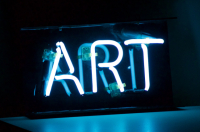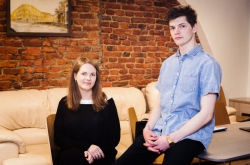Back in 2000, Charles Falco from the University of Arizona conducted a research project in collaboration with artist David Hockney; they researched the influence of optical devices on fine art techniques in classical European art. The researchers claimed that the emergence of realistic art had to do with the development of science and especially optical technologies.
The professor is sure that optical methods, as well as devices, have been used by artists since 1425 and till today. Among the pioneers in this field were such renowned masters as Rubens, Jan van Eyck, Lorenzo Lotto, Hans Holbein and others. Some elements of their paintings are extremely realistic; so, the scientists concluded that the artists surely used some technological "doping".
According to the professor, this discovery - the fact that artists made use of optical methods - is a real revolution in the history of arts. Some 2,000 years ago images were flat and artists depicted humans in two-dimensional space. Jan van Eyck succeeded in portraying a person similar to how he looked in real life. So, how did he manage to do that? In his painting Madonna del canonico van der Paele (Virgin and Child with Canon van der Paele) the artist left a hint: one of the characters holds glasses, and, according to the researchers, glasses with 2 diopter lens could be used to attain such realistic representation. What’s more, such lenses already existed at that time.
 Charles Falco
Charles Falco
"My laboratory is on the 10th floor, and there's a building nearby. If we draw a line between these two buildings, we'll get the convergence point. It is obvious that Jan van Eyck used such methods as well," shares Charles Falco.
What's more, Jan van Eyck also used projections: despite their small size, some of the details (for instance, the chandelier on the painting) retain its proportions, which allows scientists to suggest that the artists did the necessary measurements before depicting the actual object. Yet, Jan van Eyck still had his faults. For instance, he sometimes made mistakes in aligning the perspective. According to professor Falco, this means that the artist still didn't know the laws of geometrical perspective which were discovered by Filippo Brunelleschi some time later. Yet, as he got many proportions right, the researchers suppose that he made use of optical projections.
How did he do that? Historians would answer that this was quite possible since Galileo's times, though few people used this method. Yet, Charles Falco proved that even some 75 years before Galileo artists had already used different scientific life-hacks.
On Lorenzo Lotto's Husband and Wife (1523), part of the weave of the tablecloth is not in focus while its frontal part is. That is also evidence of an artist using optics, believes the expert.
 Lorenzo Lotto's Husband and Wife Credit: liveinternet.ru
Lorenzo Lotto's Husband and Wife Credit: liveinternet.ru
Having conducted the necessary research, professor Falcone came to a conclusion that the artist used an optical device, as one can not attain such focusing depth with the unaided eye. What is more, the outlying elements of the tablecloth are in focus, as well, and the elements of the weave do not add up completely, so it seems like the artist tweaked his device a bit. All of that can be seen as evidence to the fact that Lorenzo Lotto used geometrical optics 75 years before Galileo did.
"We are not claiming that optics is the only way to align perspective, but we are saying that optics provides the only opportunity to misalign it when an artist needed that," explains Charles Falco.
One can read more about this research on art-optics.com.
Paola Antonelli, Director of R&D at The Museum of Modern Art (MoMA), New York City, told the audience about the new ties between the digital and physical world that are created by designers and scientists. She showed photographs of items they've exhibited at MoMA in different years, thanks to which MoMA became a site where designers and scientists meet and pose new global questions.
 Paola Antonelli
Paola Antonelli
According to the expert, designers stimulate evolution, as they give people the opportunity to use the benefits of progress. With time, scientists have affected their perception in such a way that the idea of even the simplest objects the designers work on changed. Now, design and science closely interact with each other.
"Our Elastic Mind exhibition is something like a digital world that has become most important in the sense of interaction of science and art; it is no longer about biology, but the digital world that has now become so vast," shares Paola Antonelli.
During certain exhibitions at MoMA, they've presented various futuristic projects on growth and aggregation. For instance, among them was the Pig Wings Project by Oron Catts and the Victimless Leather project - leather that can be "grown" independently, so that there's no need for killing animals. Several years later, the Grow Your Own project was presented, where humans could grow cheese from their own bacteria.
Hybridism is an important trait of modern design; in a sense, it is the vast field that is at the conflux of physical and digital world that both designers and scientists have to immerse in. By inventing new instruments, developers aim to solve challenging problems and raise new global questions. For instance, MoMA started to develop videogames, which Paola Antonelli believes to be an example of interactive design.
"Games can be solely about behavior. For instance, many children like games where they can develop their character's personality. Games allow us to experiment with different forms of design, as they are not just code and hardware - we constantly work together with programmers and game developers so as to understand what games are," shares Ms. Antonelli.
A good example of such collaboration is the game «Generations» by developer One Life Remains (2015); according to MoMA's curators, it is impossible to complete it in one’s lifetime, so children can continue playing it using their parents’ achievements.
Another good example of a hybrid project that combines natural and digital technology is the Silk Pavillion (2013). A team of researchers from the Massachusetts Institute of Technology created a special frame with silk threads that silkworms use to build their pods. 6,500 silkworms were planted on the frame, and have indeed constructed a gigantic sculpture made of silk.
Another idea is introducing mechanics into human bodies. More and more often, scientists and designers focus on self-improvement. For instance, Hugh Herr develops new bionic prostheses. Having lost both legs during a mountaineering accident, he is now head of a mechatronics team MediaLab at MIT; the hi-end bionic technologies they develop allows him to run, dance and even climb mountains again.
Design can also be used to solve problematic issues and set new challenges: for instance, Japanese designer's Ai Hasegawa's project (Im)possible Baby, Case 01: Asako & Moriga (2015) tells us about a yet impossible situation where a female same-sex couple don’t require male semen to conceive children.
"Design helps us think of different forms of existence, about who we are and what we want. From this point of view, genetic manipulation is most interesting, as it raises questions about our past, our future, and its possible dangers," concludes Paola.
We'd like to remind you that the “Art&Science: Art, Science, Museum Project” included eight open lectures during which 16 leading experts in the field of Art & Science from all over the world made their presentations. One can find the project’s archive here.





